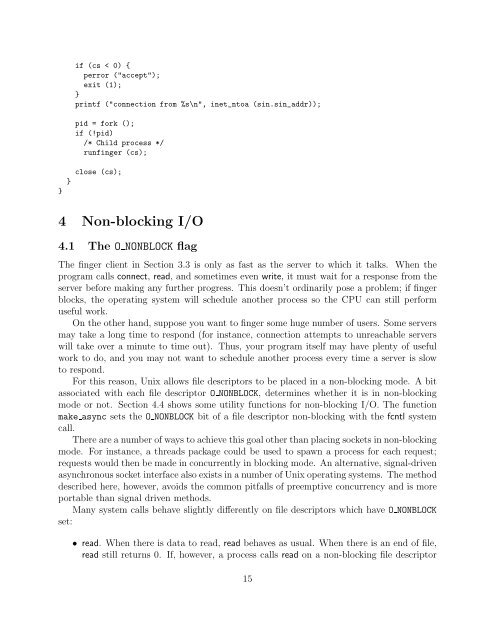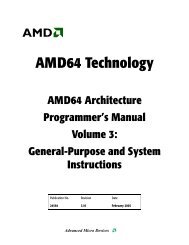Using TCP Through Sockets
Using TCP Through Sockets
Using TCP Through Sockets
Create successful ePaper yourself
Turn your PDF publications into a flip-book with our unique Google optimized e-Paper software.
}<br />
}<br />
if (cs < 0) {<br />
perror ("accept");<br />
exit (1);<br />
}<br />
printf ("connection from %s\n", inet_ntoa (sin.sin_addr));<br />
pid = fork ();<br />
if (!pid)<br />
/* Child process */<br />
runfinger (cs);<br />
close (cs);<br />
4 Non-blocking I/O<br />
4.1 The O NONBLOCK flag<br />
The finger client in Section 3.3 is only as fast as the server to which it talks. When the<br />
program calls connect, read, and sometimes even write, it must wait for a response from the<br />
server before making any further progress. This doesn’t ordinarily pose a problem; if finger<br />
blocks, the operating system will schedule another process so the CPU can still perform<br />
useful work.<br />
On the other hand, suppose you want to finger some huge number of users. Some servers<br />
may take a long time to respond (for instance, connection attempts to unreachable servers<br />
will take over a minute to time out). Thus, your program itself may have plenty of useful<br />
work to do, and you may not want to schedule another process every time a server is slow<br />
to respond.<br />
For this reason, Unix allows file descriptors to be placed in a non-blocking mode. A bit<br />
associated with each file descriptor O NONBLOCK, determines whether it is in non-blocking<br />
mode or not. Section 4.4 shows some utility functions for non-blocking I/O. The function<br />
make async sets the O NONBLOCK bit of a file descriptor non-blocking with the fcntl system<br />
call.<br />
There are a number of ways to achieve this goal other than placing sockets in non-blocking<br />
mode. For instance, a threads package could be used to spawn a process for each request;<br />
requests would then be made in concurrently in blocking mode. An alternative, signal-driven<br />
asynchronous socket interface also exists in a number of Unix operating systems. The method<br />
described here, however, avoids the common pitfalls of preemptive concurrency and is more<br />
portable than signal driven methods.<br />
Many system calls behave slightly differently on file descriptors which have O NONBLOCK<br />
set:<br />
• read. When there is data to read, read behaves as usual. When there is an end of file,<br />
read still returns 0. If, however, a process calls read on a non-blocking file descriptor<br />
15
















